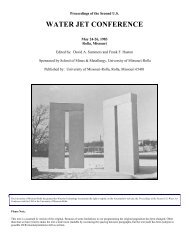proceedings of the fourth us water jet conference - Waterjet ...
proceedings of the fourth us water jet conference - Waterjet ...
proceedings of the fourth us water jet conference - Waterjet ...
You also want an ePaper? Increase the reach of your titles
YUMPU automatically turns print PDFs into web optimized ePapers that Google loves.
After each sample had been cut to measure 5 x 7.5 cm it was placed in <strong>the</strong> holder,<br />
<strong>the</strong> sample length was adj<strong>us</strong>ted to exceed only slightly <strong>the</strong> anticipated depth <strong>of</strong> cut, in<br />
order to provide maximum sample stability. A cutting run was made. The pump was<br />
raised to <strong>the</strong> required pressure prior to <strong>the</strong> test, and <strong>the</strong> traverse conditions were such that<br />
<strong>the</strong> samples had accelerated to <strong>the</strong> required velocity before <strong>the</strong>y passed under <strong>the</strong> <strong>jet</strong>.<br />
Similarly deceleration did not occur until after <strong>the</strong> sample carriage had passed beyond <strong>the</strong><br />
<strong>jet</strong>. After cutting, <strong>the</strong> depth <strong>of</strong> cut was determined by <strong>us</strong>ing a thin metal ruler. On every<br />
specimen between four and seven depth values were taken, <strong>the</strong> final result was <strong>the</strong>n<br />
obtained by averaging <strong>the</strong> values measured for <strong>the</strong>se depths.<br />
Where polymer was added to <strong>the</strong> <strong>water</strong>, before test, <strong>the</strong> procedure was slightly<br />
different. The polymer was added to a container full <strong>of</strong> fresh filtered <strong>water</strong>. After adding<br />
<strong>the</strong> liquid polymer <strong>the</strong> solution was stirred vigoro<strong>us</strong>ly by hand for between 15 and 20<br />
minutes. The solution was <strong>the</strong>n immediately <strong>us</strong>ed, any fluid remaining after <strong>the</strong> test was<br />
disposed after <strong>the</strong> experiment. Th<strong>us</strong>, for every test at a new polymer concentration, a<br />
fresh mixture was prepared.<br />
RESULTS<br />
The results for <strong>the</strong> experiments were analyzed <strong>us</strong>ing <strong>the</strong> desk-top computer<br />
program Statview 512, available for <strong>the</strong> Macintosh computer. Several regression models<br />
were considered. Among <strong>the</strong>se <strong>the</strong> best correlation coefficients were achieved when <strong>the</strong><br />
exponential model was <strong>us</strong>ed. A general equation <strong>of</strong> <strong>the</strong> model can be expressed as below:<br />
where<br />
D = k ⋅ P y ⋅ V z . . . . . . . . . . . . . . . . . . .(1)<br />
D is <strong>the</strong> depth <strong>of</strong> cut (cm)<br />
P is <strong>the</strong> <strong>jet</strong> pressure (MPa)<br />
V is <strong>the</strong> traverse speed (cm/sec)<br />
k,y,z are <strong>the</strong> regression coefficients<br />
For three different foam types and five different nozzle diameters, individual<br />
relations are given in <strong>the</strong> form above in table 3. A multiple regression on <strong>the</strong> 375 data<br />
points indicated that <strong>the</strong> equation correlating <strong>jet</strong> performance with parameters can be<br />
expressed by <strong>the</strong> equation<br />
where<br />
D = 16.305 f − 0.97 P 1.15 n 1.44 V −0.3 . . . . . . . . . . . . . . .(2)<br />
f is <strong>the</strong> foam density in kg/m 3<br />
n is <strong>the</strong> nozzle diameter measured in mm<br />
The equation had an R-squared value <strong>of</strong> 0.945. A similar procedure was<br />
developed to analyze <strong>the</strong> results <strong>of</strong> Foam #1 when different concentrations <strong>of</strong> polymer<br />
were <strong>us</strong>ed in <strong>the</strong> feed <strong>water</strong>. Again a multiple regression equation was generated <strong>us</strong>ing<br />
135 data points <strong>of</strong> <strong>the</strong> form:<br />
25















